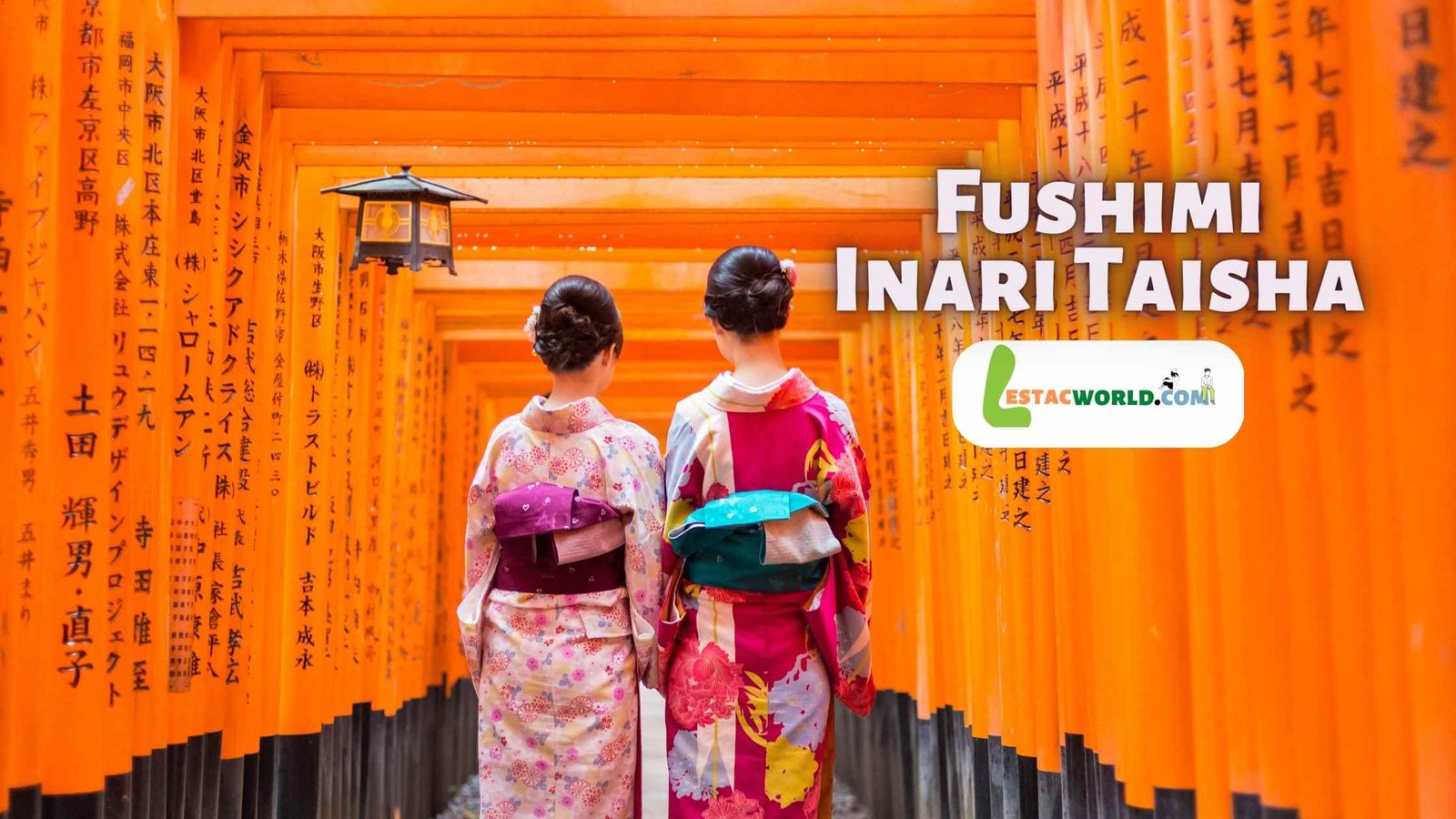About Fushimi Inari Taisha
About Fushimi Inari Taisha – Shinto is the religion practiced at Fushimi Inari Taisha, which is a shrine that can be found in the Japanese city of Kyoto. It is an offering to the Shinto god Inari, who is revered as the patron of fertility, agriculture, success, and wealth. The temple is widely regarded as one of the most significant and well-known attractions in Kyoto, and it receives millions of tourists on an annual basis.
The complex of shrines occupies an area of more than 33,000 square meters and includes a large network of routes that climb to the holy Mount Inari. Visitors may discover thousands of torii gates along these trails. Tori gates are traditional Japanese gateways that represent the transition from the secular world to a sacred area. Visitors can locate torii gates throughout these routes. The vivid vermilion color of the torii gates that can be found at Fushimi Inari Taisha is easily recognizable, and the gates are organized in a sequence that guides tourists farther up the mountain.
Along the paths leading to Fushimi Inari Taisha are a plethora of minor shrines as well as stone statues of foxes. It is claimed that these fox statues are messengers of Inari. People often identify the god with foxes, and in the belief that doing so will earn them the favor of the god Inari, they bring food and other presents to place as sacrifices at shrines dedicated to him.
Fushimi Inari Taisha is not only significant on a spiritual level, but it is also a very popular tourist site due to the breathtaking views it provides of the city and the countryside in the surrounding area. The trails are suitable for hiking, and the trip to the peak of Mount Inari often takes between two and three hours to complete.
Visitors to Fushimi Inari Taisha have the opportunity to take part in traditional Shinto rites. These rituals include making offerings at the shrines and purifying themselves by drinking water from a fountain designated for that purpose. They also have the option of purchasing omamori, which are traditional Japanese talismans that are thought to provide benefits such as success, protection, or luck.
The Fushimi Inari Taisha Shrine is open around the clock, and there is no charge to visit. Anyone who is interested in the culture and spirituality of Japan is strongly encouraged to pay a visit to the shrine, which can be reached by train from the Kyoto Station.
History of Fushimi Inari Taisha
One of the most historically significant shrines in Japan is located in Fushimi Inari Taisha, which is also one of the oldest. It is not known when exactly it was established, but it is assumed to have been in the early 8th century, which would make it over 1200 years old. The actual date of its founding is unknown.
The shrine was initially constructed to pay homage to Inari, the patron deity of agriculture and commerce. It was revered as a significant place of worship by those involved in the agricultural and commercial industries. Over the course of its history, it has come to be connected with the flourishing and achievement of commercial ventures, and as a result, it has evolved into one of the most well-known and frequented temples in all of Japan.
During the Edo period (1603-1868), Fushimi Inari Taisha developed into a significant hub for the worship of Inari. Thousands of people from all across Japan traveled to the temple to pay their respects. The shrine was also a symbol of the riches and power of the merchant class, and it was supported by wealthy merchants who gave considerable donations. In addition, the shrine was a place of worship for the people.
Major renovations and improvements were made to the shrine in the latter half of the 19th century and the early part of the 20th century. These included the construction of the current main shrine building as well as the installation of thousands of vermilion torii gates that line the trails that lead up the mountain.
Today, millions of people still make the journey to Fushimi Inari Taisha each year in order to worship Inari, seek blessings for their enterprises, and take in the scenic splendor of the mountain and the shrine complex. Despite its popularity, the shrine maintains its status as a place of spiritual significance and continues to be an important part of Japan’s religious and cultural life.
How to reach Fushimi Inari Taisha
The Fushimi Inari Taisha is a Shinto shrine that may be reached quickly and simply by using the public transit system in Kyoto, Japan. The following is a list of the several routes leading to the shrine:
If you are traveling to Fushimi Inari Taisha by train, the JR Inari Station is the station that is located the closest to the temple. It is only a few minutes’ walk from the shrine. This station is a handy starting place for travelers traveling from Kyoto Station or other locations in Kyoto as it is served by both local and rapid trains on the JR Nara Line.
You can also get there by city bus from Kyoto Station or other sections of the city; the shrine is serviced by city buses. The “Inari” bus stop, which is situated just outside the grounds of the shrine, can be reached by taking any of the following buses: 5, 206, or 207.
Taxis are another option, and they can carry guests directly to the shrine from Kyoto Station or other locations in the city. Taxis are readily available. Those who have a lot of luggage or who would rather not take public transit could benefit from this choice because it is more convenient.
It is important for tourists to leave sufficient time to reach the shrine, regardless of the means of transportation they choose, but this is especially important during the high season for tourism. Once tourists reach the shrine, there are plenty of signs and English maps available to assist them in navigating their way around. In addition, the surrounding area features a large number of stores and restaurants, making it convenient for those who need to take a break or grab a bite to eat.
Also read – 10 days Japan Tour package
Do's and Dont's at Fushimi Inari Taisha
Fushimi Inari Taisha is a revered shrine in Japan, and visitors are expected to show respect and follow certain customs while visiting. Here are some do’s and don’ts to keep in mind when visiting Fushimi Inari Taisha:
Do’s:
- Dress appropriately: Visitors should dress respectfully, covering their legs and arms, and removing hats or head coverings when entering the shrine grounds.
- Purify yourself: Before entering the main shrine building, visitors should purify themselves by washing their hands and mouth at the purification fountain located outside.
- Make an offering: Visitors are encouraged to make a small offering at the main shrine building, such as a coin or a prayer.
- Bow and clap: When visiting the main shrine building, visitors should bow twice, clap their hands twice, bow again, and then make their offering.
- Respect the peace and quiet: Fushimi Inari Taisha is a place of worship and contemplation, and visitors should be quiet and avoid making loud noises while visiting.
Don’ts:
- Don’t take photos inside the main shrine building: Photography is generally prohibited inside the main shrine building, and visitors should be mindful of respecting the sanctity of the space.
- Don’t touch or climb on the sacred objects: Visitors should not touch or climb on the torii gates, stone fox statues, or other sacred objects at the shrine.
- Don’t litter: Visitors should keep the shrine grounds clean and free of litter.
- Don’t eat or drink inside the shrine grounds: Visitors should avoid eating or drinking inside the shrine grounds, and should wait until they are outside to enjoy a snack or drink.
By following these customs and showing respect for the shrine and its history, visitors can have a meaningful and memorable experience at Fushimi Inari Taisha.
Highlights of Fushimi Inari Taisha
Fushimi Inari Taisha is a shrine located in Kyoto, Japan, and is considered one of the most important and historically significant shrines in the country. Here are some of the highlights of the shrine that visitors should not miss:
- The Thousands of Torii Gates: The most famous feature of Fushimi Inari Taisha is its thousands of vermilion torii gates, which line the trails leading up the mountain behind the shrine. These gates, donated by individuals and businesses, symbolize the passage from the everyday world to the spiritual realm.
- The Main Shrine Building: The main shrine building at Fushimi Inari Taisha is a beautiful and historic structure, which was rebuilt in the late 19th century and is considered one of the best examples of traditional shrine architecture in Japan.
- The Fox Statues: Foxes, or kitsune, are believed to be messengers of Inari, and there are many fox statues throughout the shrine grounds, including several large stone foxes guarding the main shrine building.
- The Mountain Trail: The trails leading up the mountain behind the shrine are a highlight of any visit to Fushimi Inari Taisha. Visitors can hike the trails and enjoy the beautiful scenery, as well as see the thousands of torii gates up close.
- The Shrine Complex: In addition to the main shrine building and the mountain trail, there are many other shrines, temples, and buildings within the shrine complex that visitors can explore, including the Okusha (inner shrine), the Romon Gate, and the worship hall.
Whether you are interested in history, spirituality, or just a scenic hike, there is something for everyone at Fushimi Inari Taisha. Visitors can spend hours exploring the shrine complex, hiking the trails, and taking in the beauty and significance of this important religious site.


Comment (0)